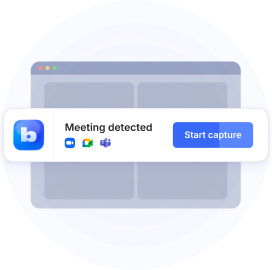
The modern workplace has become a battlefield of tasks, notifications, and back-to-back meetings. Modern-day workers have come a long way from needing just tools. They now need intelligent allies. Among them is Granola, a deceptively simple meeting tool that sits in your Mac’s menu bar, listening, capturing, and summarizing your meetings.
In 2025, AI note-taking has moved from novelty to necessity. According to Microsoft’s 2023 Work Trend Index, employees spend 57% of their time in meetings and communications. That's more than half the workday talking, leaving little time to create or focus.
Most professionals are also stuck manually taking notes or distilling key points after meetings, often while prepping for the next. Research shows it takes 23 minutes to refocus after a task switch, multiplying the cognitive drain across a full calendar of meetings.
Granola promises to change that. Unlike many AI note-takers requiring intrusive bots, Granola captures system audio, generates meeting summaries, and integrates with personal knowledge management apps. With over $67 million raised, Granola has the backing to make a real impact, but does it deliver?
This Granola review is part of our broader series, including a comprehensive guide to the 9 best AI note-takers of 2025.
I’ve tested Granola across personal calls, work meetings, and online lessons, and gathered insights from real users from across the web.
In this Granola review, I’ll share what Granola has to offer, what it doesn’t, and whether it deserves a spot in your tech stack. You can also explore other Granola alternatives to see how Granola stacks up within the broader AI meeting tools-universe.
What Is Granola AI?
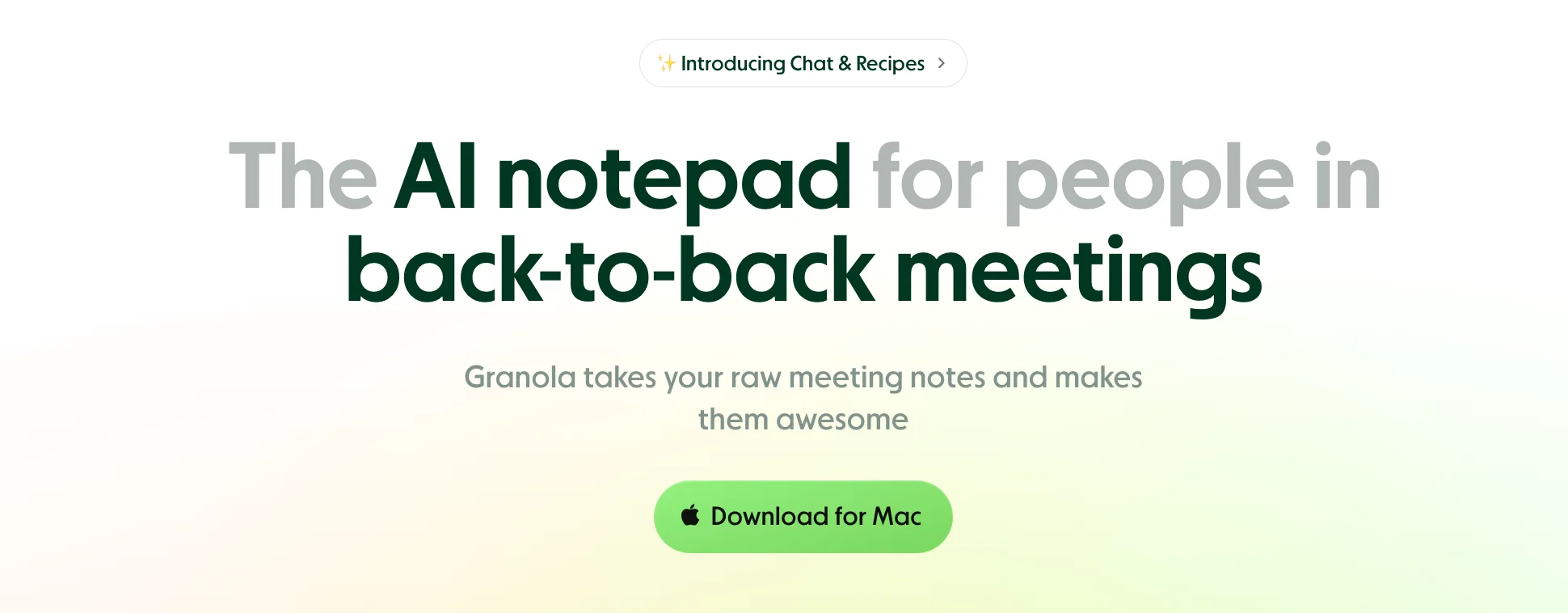
In this section of our Granola review, we’ll explore the origins, mission, and core features of Granola AI.
Granola AI is an intelligent meeting assistant designed to capture, organize, and enhance workplace knowledge using AI. Founded in 2023 by Chris Pedregal and Sam Stephenson, both veterans of product and engineering roles in tech-forward startups, Granola’s mission is to create tools that amplify human thinking and help teams work not just faster, but smarter.
I think we're living in the most exciting time for tool building since Engelbart's demo in 1968. - Chris Pedregal, Founder of Granola
At its core, Granola combines hybrid note-taking, typed meeting notes plus AI-powered transcription, with a privacy-conscious, minimal interface. It’s built to solve a persistent workplace problem: valuable insights often get lost in fleeting conversations.
Granola uses AI to organize conversations, extract key decisions and actions, and surface context in a way that teams can actually use.
Think of it as your morning bowl of granola cereal: small, easy to digest, but packed with all the nutrients (or insights) your day needs.

The launch of Granola 2.0 marked a major evolution. It has now turned into a collaborative workspace with features such as:
- Shared Team Folders: Centralized spaces for calls, feedback, and syncs, accessible even to non-Granola users.
- AI-Powered Queries: Users can chat with entire folders of transcripts, retrieving insights with source citations.
- Enterprise Discovery: Business plan users can search any public folder within their organization, supporting onboarding and cross-team knowledge sharing.
- Slack Integration: Summaries and AI chat links are automatically posted to relevant Slack channels, turning conversations into searchable, actionable knowledge.
By integrating deep AI reasoning with thoughtful UX, Granola transforms meetings from ephemeral chatter into a persistent, structured knowledge base.
As Pedregal puts it, many users often refer to Granola as their “second brain”, enabling teams to answer questions like “Why are we losing deals this quarter?” or “Which UX issues appear most often?” instantly, with context and citations.
Key Features & How Granola Works
As we continue this Granola review, we’ll break down each feature, from recording and transcription to AI-powered queries and Recipes.
Recording & Real-Time Transcription
Getting started is straightforward. Once installed on your Mac and connected to your calendar, Granola pops up automatically when a meeting begins, without meeting bots, or extra participants - just seamless transcription of your device's audio.
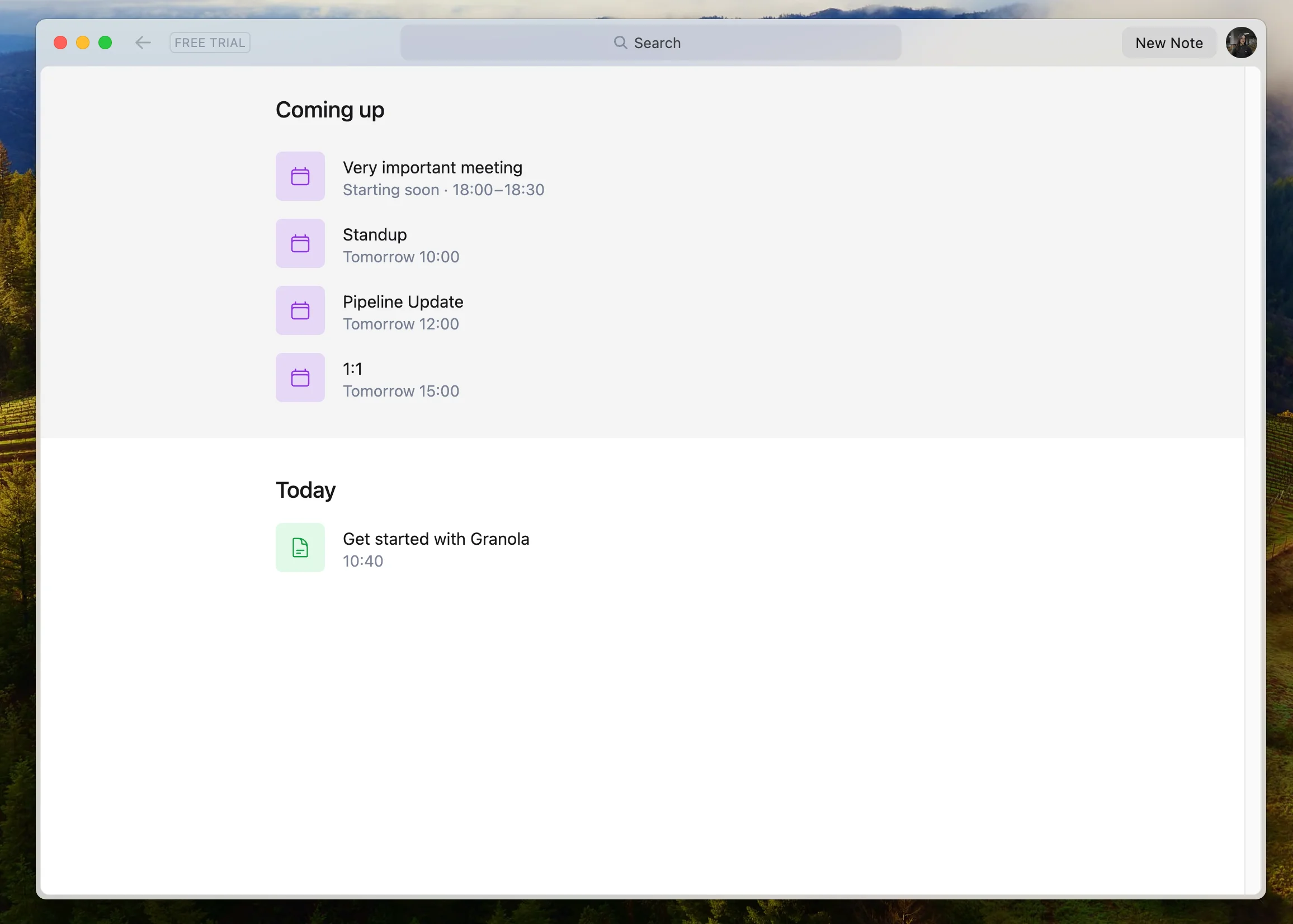
As the meeting unfolds, Granola transcribes everything in real time, with accurate speaker recognition. This live transcript is invaluable for technical discussions, client calls, or team syncs where details like speaker names matter.

The AI can identify speakers making it easy to track action items or commitments by person. After the call, you can review the full transcript or jump straight to the AI-generated summaries.
The live transcript works regardless of the platform - Google Meet calls, Slack huddles, it all works on the same principle.
Combining Human & AI Insights: Enhance Notes

One of Granola’s standout features is “Enhance Notes.” Before a call, you could jot down rough notes or questions, as you normally would. After the meeting, one click merges these notes with the transcript, producing a polished, scannable summary.

This really helps you get the best of both worlds - your raw thoughts are integrated with everything that was said, creating a record that’s immediately actionable and ready to share.
Zoom in for More Context

Granola organizes meeting notes into bite-sized summaries separated by topic, making it easy to skim key points. But if you need more detail, hovering over a summary and clicking the magnifying glass opens a pop-up with the full transcript context.
This is perfect for verifying client commitments, double-checking numbers, or confirming timelines, without scrolling through pages of raw text.
Customizable Templates & Meeting Notes
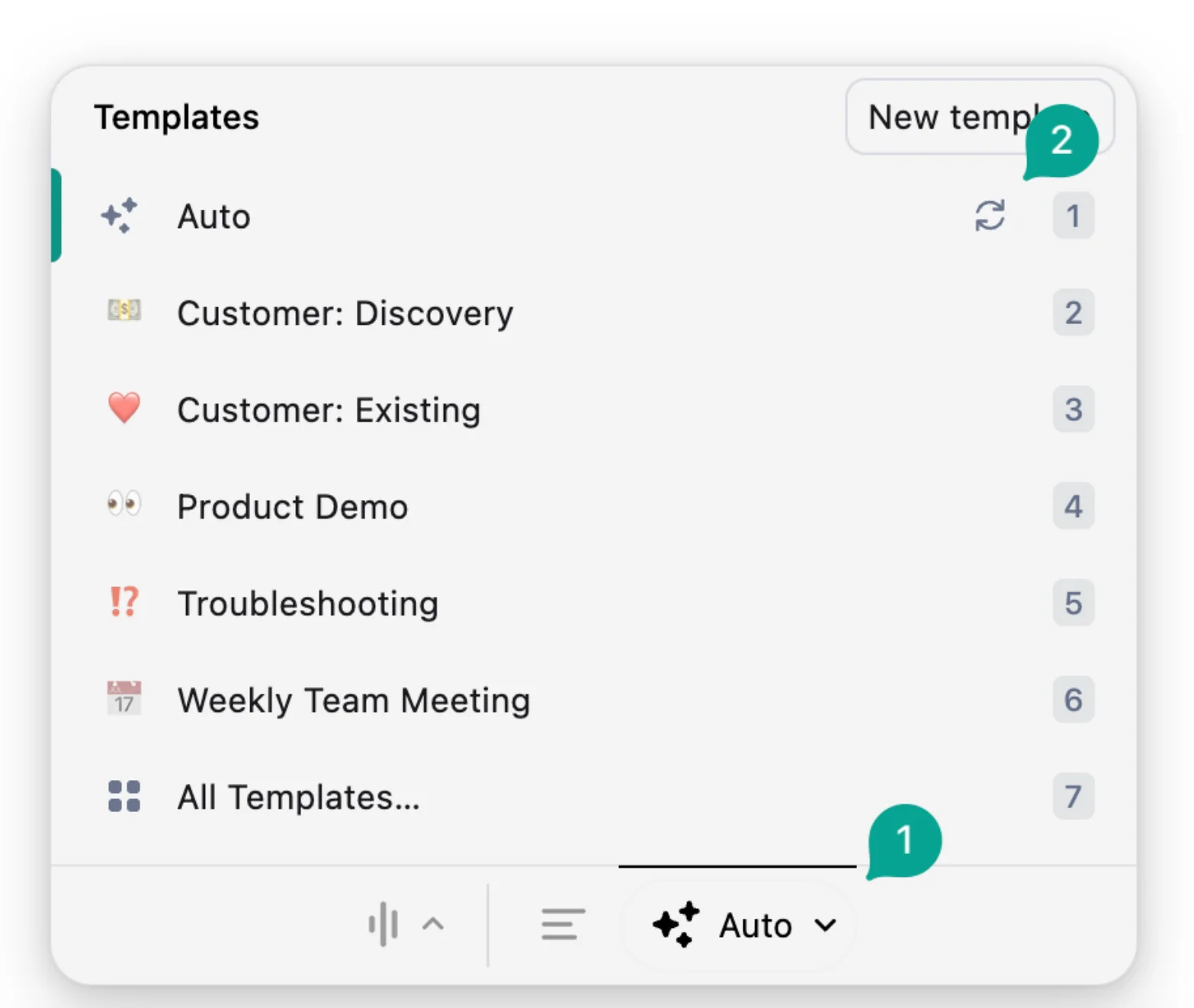
One meeting is rarely like another, and Granola gets that. It allows you to select from pre-set templates for one-on-ones, stand-ups, weekly team meetings, or create your own. This ensures meeting notes are always structured in a way that fits the meeting type.
Beyond that, Granola helps with agenda management, keeping discussions on track and objectives clear, keeping all details accounted for.
Folders, Sharing & Collaboration

Granola recently added the ability to organize notes into private or shared folders, giving teams a convenient way to keep track.
You can query entire folders with the AI — for example: “What were the most common feature requests from Q1 customer calls?” — and Granola will scan all notes to surface patterns, insights, precise points - pretty much anything you need.
Sharing is also smooth. Unlike other tools that force collaborators to create accounts, Granola lets you share notes with guest users. Guests can hover for context, explore summaries, and even ask questions via the AI chatbox , all without accessing the full transcript.

This makes external collaboration fast, secure, and frictionless.
Action Items & Follow-Ups

Granola tracks action items automatically. When someone commits to a task during a meeting, Granola highlights it and assigns responsibility. You can set reminders to ensure follow-ups happen, which reduces the risk of tasks getting overlooked.
This is especially useful for project managers, sales leaders, or anyone managing multiple moving parts across teams.
Slack, Notion, Attio, Affinity, HubSpot & Zapier Integrations
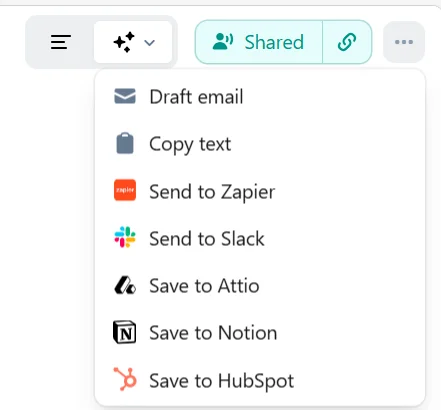
Granola integrates with Slack, Notion, Affinity, Attio and HubSpot, but the real power lies in its Zapier integration, connecting it with thousands of apps. This lets teams automate post-meeting workflows, such as:
- Automatically summarize sprint retrospectives and push them into Notion.
- Analyze sales call transcripts for high-intent leads and flag them in your CRM.
- Create organized files in Google Drive, or other platforms from new Granola meeting notes.
Slack integration is particularly powerful. After a meeting, Granola posts a concise summary directly to the relevant channel, with an AI chat option for deeper exploration.
This transforms Slack from a chaotic communication thread into a searchable, actionable go-to knowledge hub.
Smart Summaries & Multi-Meeting Insights
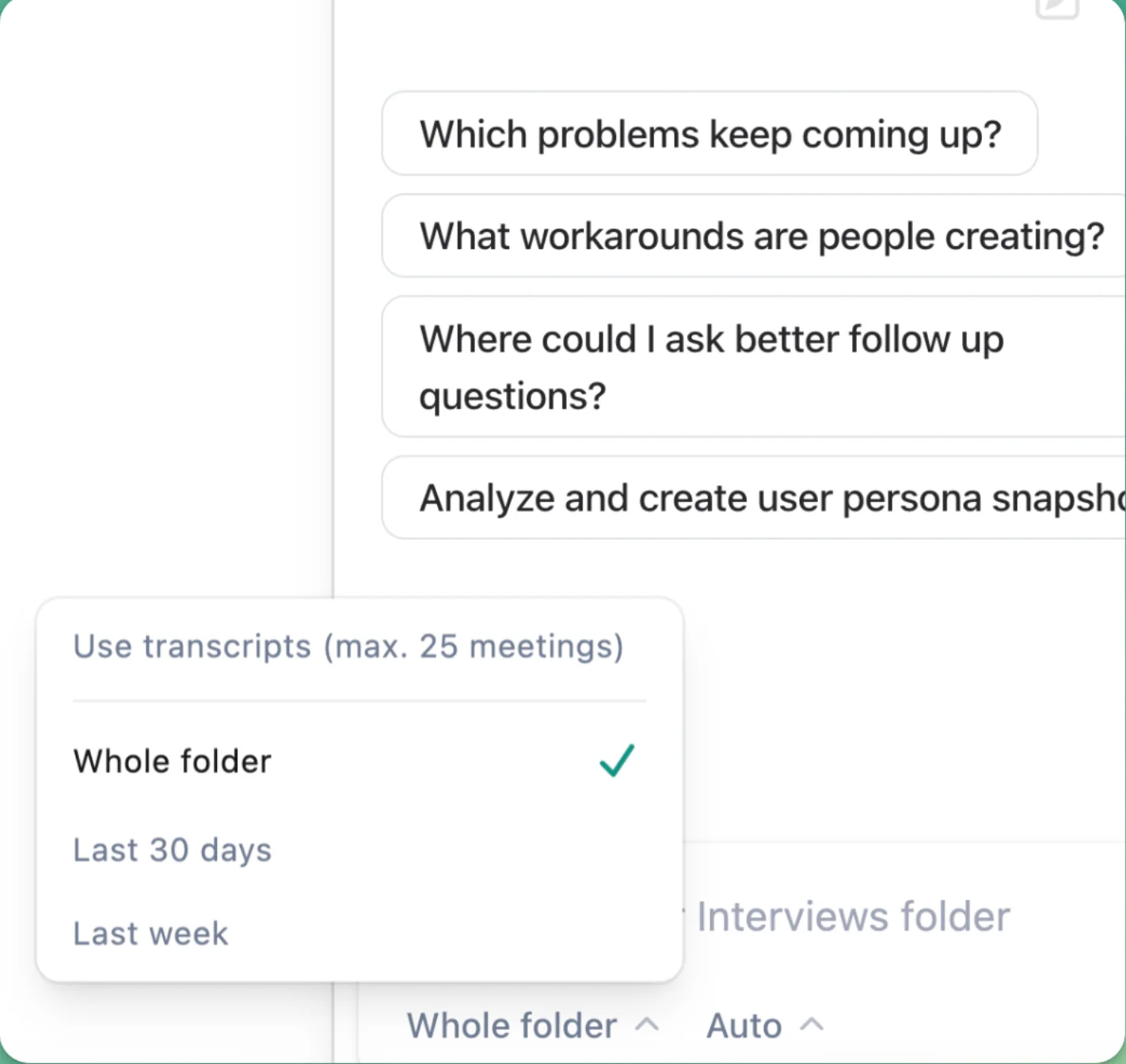
Granola doesn’t just summarize individual meetings. With folders and multi-note queries, you can analyze trends across multiple calls.
For example, you might ask: “Which features were most requested across all customer calls this quarter?” Granola will sift through the entire folder and deliver an AI-powered insight report.
This turns fragmented meeting data into team intelligence, enabling smarter, faster decisions.
Accessibility & Multi-Language Support

Granola supports multiple languages and accents, bringing good value for global teams. It also complies with accessibility guidelines, ensuring that people with disabilities can participate and benefit from AI-generated notes.
Save Time with Meeting Automation

From scheduling to hosting, Granola can automate key aspects of meetings. It can suggest optimal times based on participants’ meeting history, manage agendas, and provide structured meeting notes that link directly to action items and projects.
This reduces admin work and helps many users actually stay engaged.
Fresh from the Granola-oven: Introducing Granola Recipes

One of Granola’s newest and most innovative additions is Recipes, automated workflows that turn your meeting notes into practical, actionable outputs. Think of them as AI shortcuts that use your past conversations as context. For instance, Lenny Rachitsky’s “Write PRD” recipe can transform a product discussion into a structured requirements document, while CEO coach Matt Mochary’s “Coach Me” analyzes your week’s meetings to offer tailored leadership feedback. Over time, Recipes will become even more powerful, integrating with tools like Linear and generating editable documents right inside Granola. It’s a smart way to extract real insights from your meeting record, not just store it.
User Experience & Interface
Granola’s appeal really comes down to how smooth it feels in everyday work, where we're overwhelmed with tools already. Here’s where Granola gets things right (and where it still has room to grow).
Setup & Onboarding
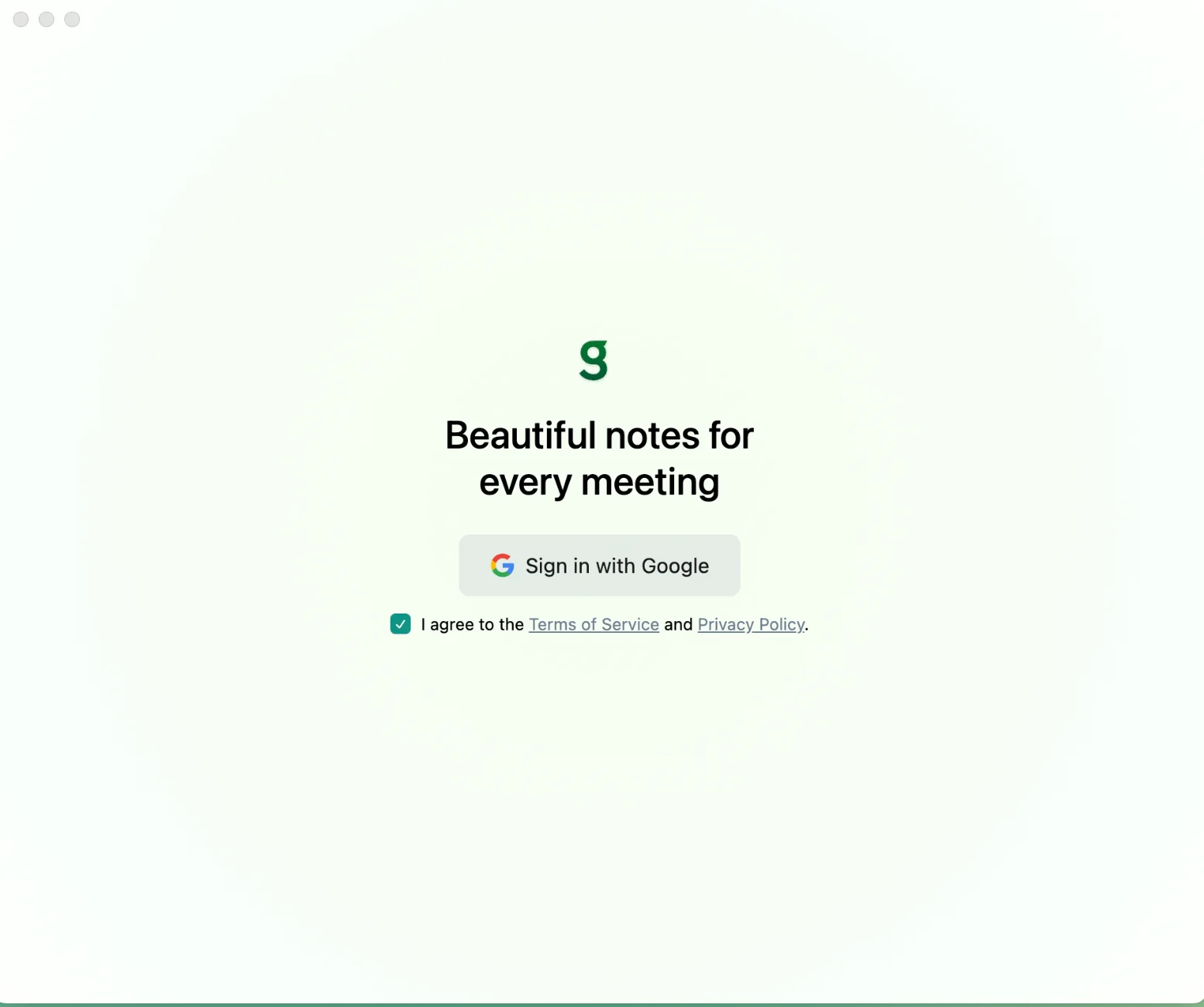
Getting started with Granola is about as painless as it gets. Install it on your Mac, connect your Google calendar, grant a couple of permissions, and you’re in. Granola doesn't serve you endless tutorials or pop-ups.
The welcome screen that already feels familiar, especially if you’re used to Apple’s minimal interfaces like Notes.
Day-to-Day Use

During a meeting, Granola’s interface stays minimal. You’ll see a live transcript updating line by line, plus your own notes pane if you want to jot things manually. It doesn’t try to shove ten features in your face while you’re talking.
One neat trick is how it integrates with your Google calendar. If you’ve got back-to-back calls, Granola detects them automatically and can prompt you when they begin.
You don’t have to remember to hit record each time, your notes are waiting without any extra clicks.
You can also run it in a more “manual” way by starting a new note, choosing participants, and letting it transcribe your voice directly.
This is handy for quick one-to-one Slack huddles, in-person chats, or even dictating ideas when you’re working solo.
When the meeting wraps, Granola offers you options: keep going, or boost your notes. The “enhance” function combines your rough notes with the AI transcript to create something cleaner, so you end up with structured meeting minutes organized by bullet points.
Platform Availability
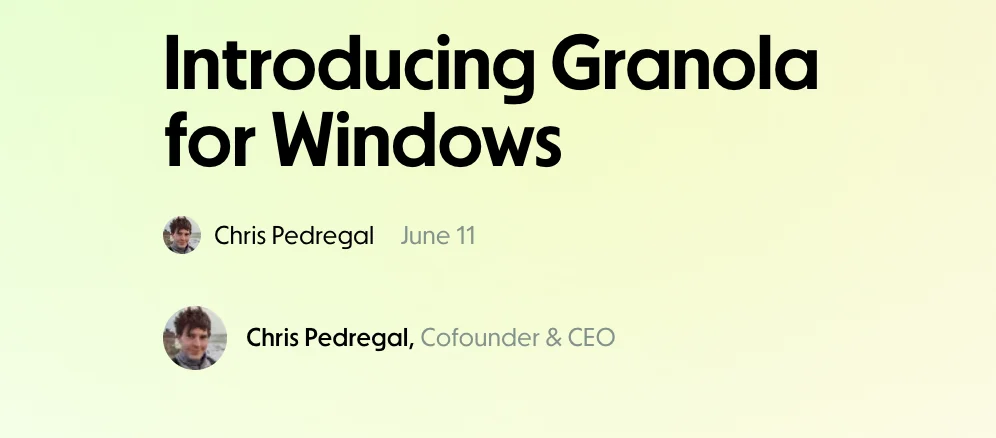
Granola started life as a macOS-only app, which explains why it feels so polished on that platform. In recent updates, they’ve added iOS support too, letting you transcribe phone calls or in-person meetings right from your iPhone. Lock screen controls make it surprisingly practical for taking notes on your mobile.
Windows support is still early-stage. Some beta features exist, but if you’re not on Mac or iOS, you may feel like Granola isn’t quite ready for you yet.
☝️ One key takeaway from our hands-on Granola review is how intuitive the interface feels, even for first-time users.
Real-Customers Granola Reviews
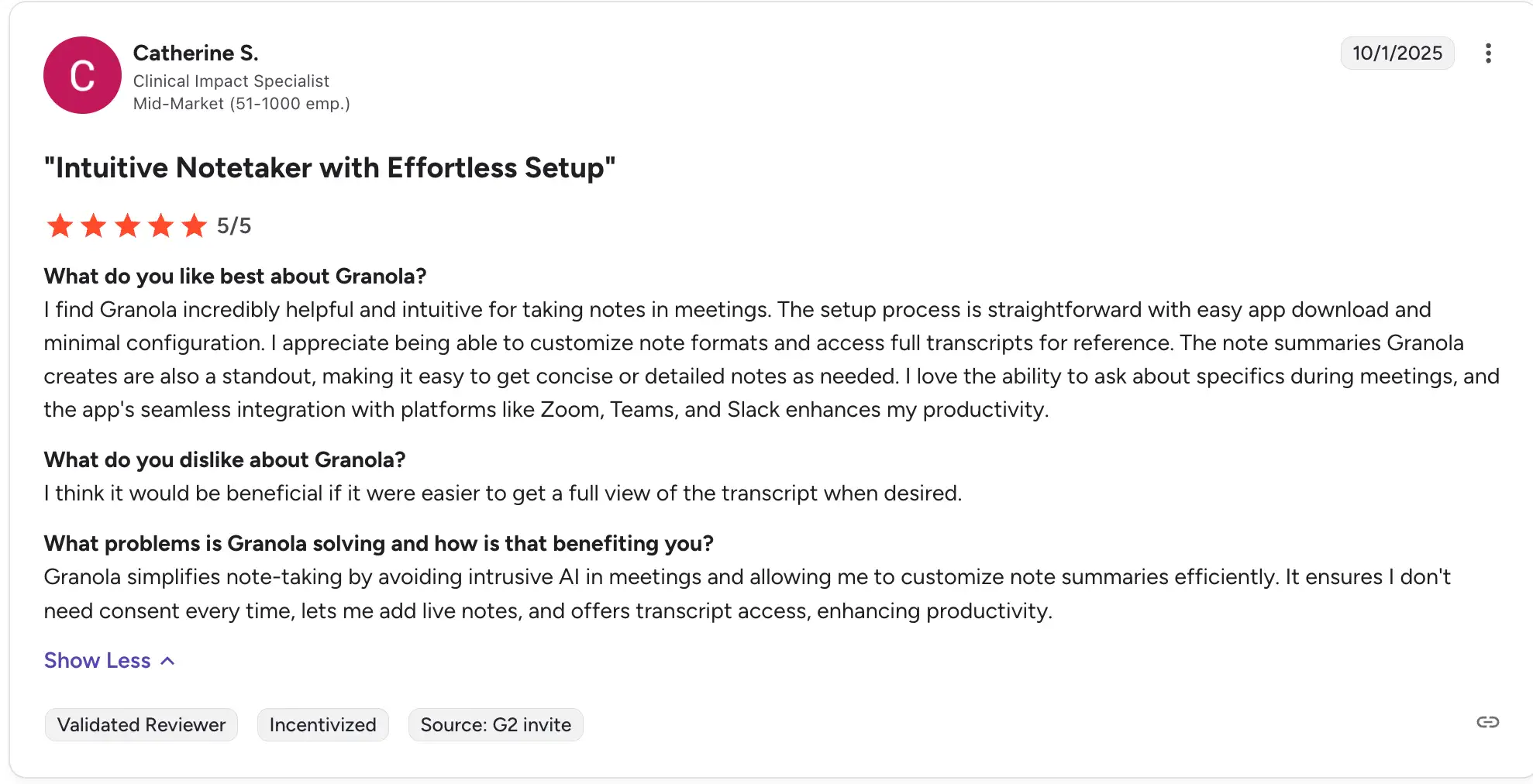
Source: G2.com

Source: Product Hunt
Performance, Accuracy & Limitations
In our Granola review, we noticed that while transcription accuracy is high, speaker identification can be inconsistent, especially in larger meetings.
Simplicity Meets Power
The magic of Granola is its simplicity. You just start a meeting, click “Take Notes,” and Granola handles the rest: live transcription, AI-powered summaries, smart insights, and integration with the tools you already use.
It’s unobtrusive, fast, and minimalistic, but packed with AI-driven intelligence that makes meetings feel less chaotic and more productive.
Transcription Accuracy
Granola's clean audio environments (think quiet rooms, decent mics) Granola’s transcription quality is strong, often in the 90–95% accuracy range. For team syncs or client calls, that’s usually more than enough to follow the thread.
Where it struggles is the same place every speech-to-text tool does: overlapping voices, heavy accents, or background noise. If you’re in a chaotic open office, expect a few misses.
Speaker Recognition
Here’s where Granola’s design choice (not using a visible bot) can work against it. Because Granola isn’t tied to individual logins or audio streams, it doesn’t always get speaker names right. Granola might blur who said what, which can be a headache, if you’re tracking commitments by person.
For personal productivity, not being able to identify speakers is a minor annoyance, but for team accountability, it’s worth noting.
Granola Plans & Pricing
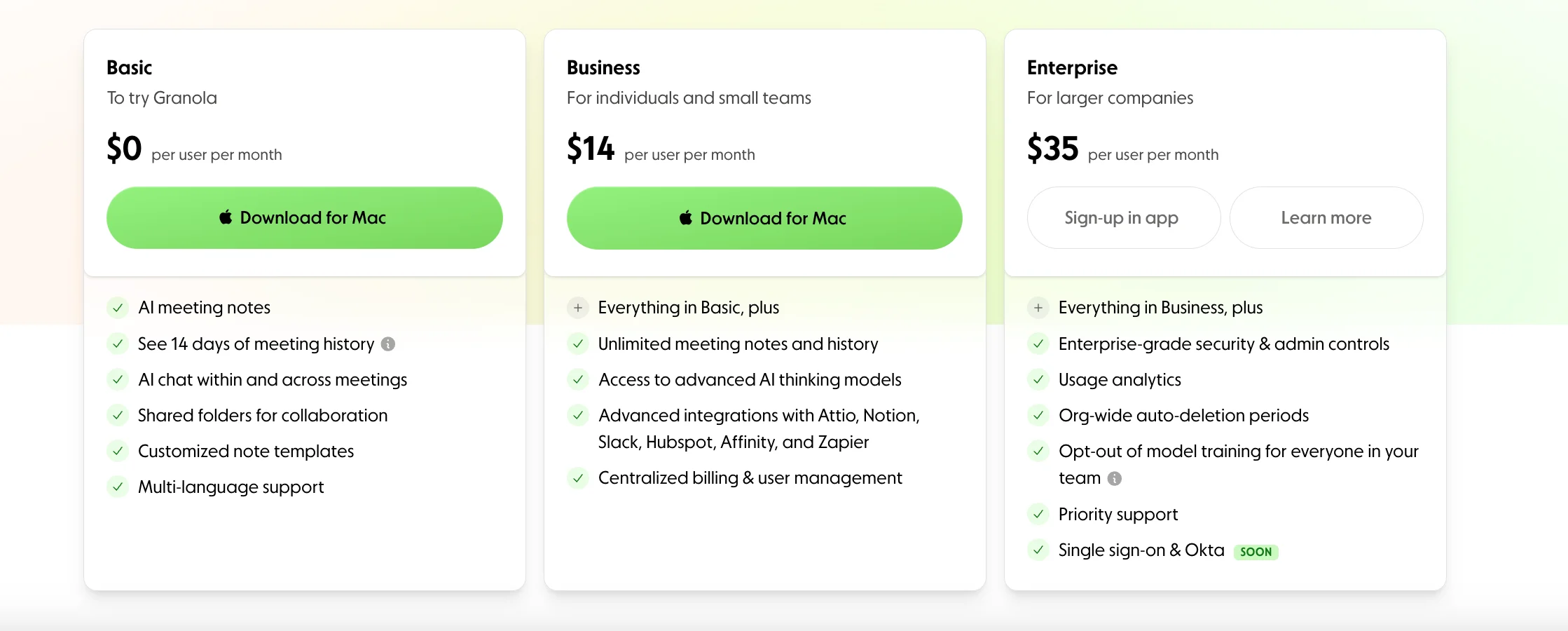
Granola uses a freemium model, letting you try before you buy, but after a point you’ll hit a ceiling unless you upgrade. As of 2025, here’s how their pricing breaks down:
Free Plan (Trial)
The free plan is ideal as a way to test-drive Granola with minimal commitment.
- You get 25 free meetings per account forever.
- Access to AI chat for all your meeting notes
- Ability to create custom note templates
- Basic features are included, though with restrictions on history and usage
Because you’re limited to 25 meetings, the free tier is best for light users or for evaluating whether Granola fits your workflow.
Individual: $18 / month
This plan is tailored for solo users who attend many meetings and want full AI support.
- Unlimited meeting use (no cap on number of meetings)
- Keeps all the features from Free (chat, templates)
- More history access, better AI models, etc.
If you run a solo business or just want to stop worrying about meeting limits, this is the sweet spot for most users.
Business: $14 / user / month
For small or midsize teams, this tier adds collaboration, admin controls, and workflow scale.
- Everything in Individual, plus:
- Team folders for shared meeting knowledge
- Centralized billing & user management
- Access to advanced integrations (Notion, Slack, HubSpot, Zapier, Attio, etc.)
- Unlimited meeting notes across all users
This tier hits a better price per user for teams needing shared context and oversight.
Enterprise: Starts ~$35 / user / month
Geared for larger organizations with stricter compliance, privacy, and scale needs.
- Everything in Business, plus:
- Opt-out of model training
- Admin controls for sharing meeting links
- Usage analytics & reporting
- Priority support, single sign-on (SSO), auto-deletion policies, enterprise-grade security
Some sources list Enterprise at $40/user when on monthly plans
Feature Gating & Value Analysis
As you move up tiers, Granola gates more history, administrative control, collaboration, and privacy features behind higher plans.
The free plan gives you a taste, but it’s the Individual and Business tiers where you unlock true value for heavy users or teams.
From a value lens, $18/month for unlimited meetings is reasonable if the time Granola saves you in taking notes, context-switching, and post-meeting action is significant. For teams, $14 per user offers discounts via scale plus collaboration benefits.
Enterprise is priced high because it delivers governance, security, and policy controls that larger companies require.
Pros & Cons of Using Granola
Granola AI offers a range of advantages that make it a compelling tool for knowledge workers, but it’s not without its limitations.
Here’s a detailed look at the pros and cons based on personal testing, user feedback, and available online insights.
🟢 Pros
1. Seamless Integration with MacOS and Calendar ✅
Granola effortlessly integrates with macOS and syncs with your Google Calendar, launching automatically for scheduled meetings. This seamless setup ensures you never miss a transcription session.
2. Bot-Free, Non-Intrusive Experience ✅
Unlike many AI tools, Granola doesn't require a bot to join your calls. It captures audio directly from your device, providing a natural and unobtrusive meeting experience.
3. Accurate Live Transcripts ✅
Granola delivers impressive transcription accuracy, even for non-native accents. Users have reported 90–95% accuracy in clean audio environments, making it reliable for various meeting types.
4. Robust Integration Ecosystem ✅
Granola includes a powerful set of integrations that streamline meeting workflows. It connects seamlessly with Slack, HubSpot, Notion, Affinity, making it easy to share notes, update CRMs, and centralize knowledge.
✍️ Worth noting: Google Calendar works best, while Outlook requires syncing as a workaround. The platform is available on Mac, Windows, and iPhone (no Android app yet), and phone call transcription works via iPhone only.
While Zapier, auto Notion exports, and a public API are still in the works, Granola’s existing integrations are stable, reliable, and function smoothly without major glitches reported.
🔴 Cons
1. Limited to Google Workspace accounts ❌
Granola requires a Google Workspace account for full functionality, including calendar syncing and AI features. Personal Gmail accounts or other personal emails are not fully supported, which can be restrictive for solo users or those outside an organization.
2. No Audio or Video Playback ❌
Granola does not record you device's audio or video, which can be a drawback for users who require verbatim quotes or need to review meeting content in its original form.
3. Speaker Names Challenges ❌
The tool may struggle with accurately assigning speaker names, especially in meetings with multiple participants or overlapping conversations, which can make tracking commitments and key contact points more difficult.
4. Limited Cross-Meeting Analysis ❌
While Granola does provide AI-powered queries within folders, it lacks advanced analytics capabilities for analyzing trends across multiple meetings or generating comprehensive insights.
5. No Bult-In Transcript Search Functionality❌
Users have reported difficulty finding specific meetings or details due to the absence of a robust search function within one meeting transcript in Granola.
6. Privacy Concerns with Data Usage❌
Granola trains its AI on user data unless opted out in the Enterprise plan. While anonymized, the lack of transparency regarding the anonymization process raises privacy concerns for some users.
Ideal Use Cases & Who Should (or Shouldn’t) Use It
Ideal User Persona No1: “Executive Emma”
Role & Environment: Emma is a product lead at a fast-growing startup. She attends 8–12 meetings per week, including team syncs, client calls, and cross-department updates. Most of her work is on macOS, with occasional use of iOS.
Needs: She needs real-time transcription, AI-generated summaries, and action item tracking to manage her packed schedule efficiently. Granola’s ability to reference meeting history ensures she can quickly review past decisions and updates. Privacy is also a priority since she deals with sensitive project details.
Workflow: Emma uses Zoom, Google Meet, and Slack. Granola automatically transcribes meetings, merges her notes with AI summaries, and posts concise updates to relevant channels.
Why Granola Works for Her: Granola lets Emma focus on meetings without losing track of most important points, commitments, or next steps. Its minimal interface, AI-powered summaries, and access to previous meeting notes save Emma's time while keeping her fully in the loop.
Ideal User Persona No2: “Consultant Carlos”
Role & Environment: Carlos is a freelance business consultant handling multiple clients remotely. His week is packed with strategy calls, project reviews, and stakeholder meetings. He works mostly on Mac and relies on Google Workspace.
Needs: He needs accurate transcripts, AI-enhanced summaries, and folder-based organization to quickly extract insights and track recurring requests across clients.
Workflow: Carlos uses Zoom, Google Meet, and Notion. Granola captures meeting transcripts, highlights action items, and organizes notes in shared folders for clients and team members.
Why Granola Works for Him: Granola keeps Carlos organized, helping him manage multiple clients without missing details. AI-powered queries let him identify patterns and important contact points efficiently, saving hours each week.
Tips to Make the Most of Granola
If you’ve ever left a meeting feeling mentally absent despite being physically present, Granola is designed to fix that, but using it effectively takes a little strategy.
➡ Embrace the AI-human collaboration model
Jot down quick notes or questions during meetings. Granola listens, transcribes, and then enhances your notes, creating summaries that reflect both what you deemed important and what the conversation actually covered.
This collaboration is what makes Granola inspiring, it strives to get the best of both worlds: human judgment and AI memory.
➡ Use the autonomy slider wisely
AI suggestions are powerful, but always double-check important points and action items. Granola clearly distinguishes its additions and links back to the exact transcript, letting you audit in a click, balancing automation and human input.
Adjust the “autonomy slider” to fit your workflow, letting AI handle repetitive tasks while you guide the meaning and context.
➡ Share interactively
Fourth, share summaries interactively. Even teammates without Granola can explore meeting highlights, ask questions, and see sources.
This encourages alignment, reduces redundant communication, and spreads adoption organically.
By combining your intuition with Granola’s AI memory, meetings become less about frantically capturing words and more about understanding, deciding, and acting. It’s a rare moment where human intelligence and AI truly complement each other.
Summary & Verdict: Does Granola Offer Good Value
In this Granola review, we found that the tool excels at turning meetings into actionable knowledge without adding friction. By capturing system audio, providing real-time transcription, and generating AI-enhanced summaries, Granola ensures users never lose track of key decisions, action items, or prevous history.
Shared team folders, AI-powered queries, and integrations with Slack, Notion, HubSpot, and other platforms make collaboration smooth, while Granola's minimal, bot-free interface keeps meetings distraction-free.
For solo professionals, Granola’s Individual plan offers excellent value, and the free tier provides a no-risk way to test the platform with up to 25 meetings.
Unlimited meeting transcription, AI summaries, and access to previous history allow users to streamline workflows and reduce the cognitive load of switching between calls and notes.
For teams, the Business plan brings added value through shared folders, centralized billing, and advanced integrations, ensuring everyone has access to the same organized knowledge base, while having access to priority support.
That said, Granola isn’t perfect. It requires a Google Workspace account, struggles with speaker names in complex meetings, and lacks robust cross-meeting analytics or audio/video playback.
Despite these limitations, Granola's focus on simplicity, privacy, and actionable insights makes it a compelling choice for knowledge workers who prioritize efficiency over verbatim transcripts.
Granola Review Verdict: If your work revolves around meetings, and you need a reliable, AI-powered assistant to keep track of decisions, action items, and history, Granola delivers strong value. Its free tier makes it easy to try, while the paid plans save time, reduce context-switching, and turn ephemeral discussions into a structured, searchable knowledge base.
Sturdy Granola Alternative: Bluedot AI
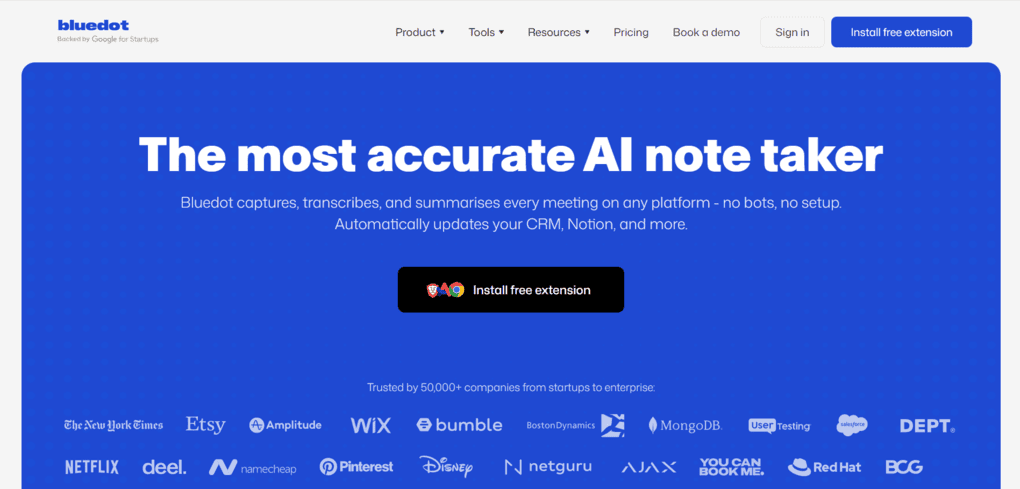
For teams that want every meeting captured, analyzed, and actionable without lifting a pen, Bluedot positions itself as a strong (possibly smarter) alternative to Granola.
While Granola supports taking notes, Bluedot replaces it entirely, transcribing meetings automatically and providing instant AI-generated insights, saving hours each week and eliminating the risk of missed details.
Its analytics tools go beyond simple summaries, offering talk ratios, engagement metrics, and speed analysis, so teams can understand how meetings are really functioning.
Meanwhile, the AI chat function allows users to query transcripts instantly, surfacing key decisions, commitments, or patterns across meetings with ease.
Another standout feature is video recording. Unlike Granola, Bluedot can record video and audio, which is crucial for reviewing visual context, gestures, and presentations, ensuring no nuance or detail is lost, especially in client calls, design reviews, or training sessions.
Bluedot also doesn’t require a meeting bot to join calls, keeping everything seamless and unobtrusive, but if you prefer, you can still add a bot for extra functionality.
The interface balances depth and usability, giving you full transcripts, smart summaries, and actionable insights all in one place.
With flexible integrations, audio/video recording, and multiple workflow options, Bluedot adapts to how your team works, making it more versatile than Granola.
For teams seeking complete automation, sharper insights, and smarter AI support, Bluedot turns your meetings into structured notes, insights, and analytics you can act on immediately.
Granola FAQ
Does Granola record video?
No, Granola does not record video. It focuses on capturing audio from your device and generating accurate transcripts and AI-powered summaries. This keeps file sizes small and prioritizes privacy while still providing detailed, actionable insights
Why is it recommended to record meetings?
Recording meetings ensures that every discussion, decision, and action item is captured accurately, making it easier for teams to review past conversations and track responsibilities.
It improves documentation and retrieval, reduces miscommunication, and provides a reliable reference for complex discussions.
Recordings also boost accountability, as participants know their contributions are documented, and they streamline onboarding by helping new team members understand ongoing projects quickly.
Additionally, recorded meetings support legal compliance, enhance productivity by reducing redundant discussions, and make remote collaboration more effective by keeping all team members aligned regardless of time zone or schedule.
Can you use Granola without Google Workspace?
Granola requires a Google Workspace account for full functionality, including calendar syncing and AI features. Personal Gmail accounts or other personal emails are not fully supported, which can be restrictive for solo users or those outside an organization.
Does Granola have an API?
As of now, Granola does not offer a public API. The company has stated that they currently do not have plans to support a public API, focusing instead on integrations through platforms like Zapier.
However, some users have explored alternative methods to access Granola's data. For instance, one user reverse-engineered the Granola desktop app to extract notes by intercepting API calls, though this approach is not officially supported and may violate Granola's terms of service. Our Granola review also highlights that while it lacks a public API, its integrations with Slack, Notion, and Zapier still provide robust workflow support.
Can Granola be used for ad hoc meetings or only scheduled ones?
Granola works for both scheduled and spontaneous meetings. If it detects an ad hoc discussion, it prompts you to start notes and transcription immediately, ensuring all meetings are captured, even those not on your calendar.
How does Granola handle multiple meetings or multi-note queries?
Granola lets you organize notes into folders and query across multiple transcripts. This makes it easy to identify trends, recurring requests, or important patterns across meetings without manually combing through individual notes.


.png)


